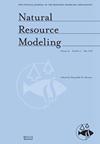环境不确定性下管理海滩宽度的风险规避选择
IF 2.1
4区 环境科学与生态学
Q3 ENVIRONMENTAL SCIENCES
引用次数: 1
摘要
应用理论的地理经济学方法,我们研究了当侵蚀的海岸海滩被滋养时(即,当填充物被放置以扩大海滩时)影响海滩宽度选择的关键因素。在这一地理经济框架内,最佳海滩宽度与其危害保护和娱乐价值呈正相关,与营养成本和贴现率负相关。使用动态建模框架,我们研究了在海平面加速下使净现值最大化的海滩宽度和营养的时间路径。然后,我们分析了由自然海岸线动态、间歇性大风暴或海平面上升引起的对预期未来海滩宽度的环境不确定性如何导致经济选择倾向于更窄的海滩。风险厌恶会以矛盾的方式影响海岸财产所有者对海滩宽度的选择:必须平衡危险保护的预期收益与重复滋养行动的预期成本。本文章由计算机程序翻译,如有差异,请以英文原文为准。
Risk averse choices of managed beach widths under environmental uncertainty
Applying a theoretical geo‐economic approach, we examined key factors affecting decisions about the choice of beach width when eroded coastal beaches are being nourished (i.e., when fill is placed to widen a beach). Within this geo‐economic framework, optimal beach width is positively related to its values for hazard protection and recreation and negatively related to nourishment costs and the discount rate. Using a dynamic modeling framework, we investigated the time paths of beach width and nourishment that maximized net present value under an accelerating sea level. We then analyzed how environmental uncertainty about expected future beach width, arising from natural shoreline dynamics, intermittent large storms, or sea‐level rise, leads to economic choices favoring narrower beaches. Risk aversion can affect a coastal property owner's choice of beach width in contradictory ways: the expected benefits of hazard protection must be balanced against the expected costs of repeated nourishment actions.
求助全文
通过发布文献求助,成功后即可免费获取论文全文。
去求助
来源期刊

Natural Resource Modeling
环境科学-环境科学
CiteScore
3.50
自引率
6.20%
发文量
28
审稿时长
>36 weeks
期刊介绍:
Natural Resource Modeling is an international journal devoted to mathematical modeling of natural resource systems. It reflects the conceptual and methodological core that is common to model building throughout disciplines including such fields as forestry, fisheries, economics and ecology. This core draws upon the analytical and methodological apparatus of mathematics, statistics, and scientific computing.
 求助内容:
求助内容: 应助结果提醒方式:
应助结果提醒方式:


